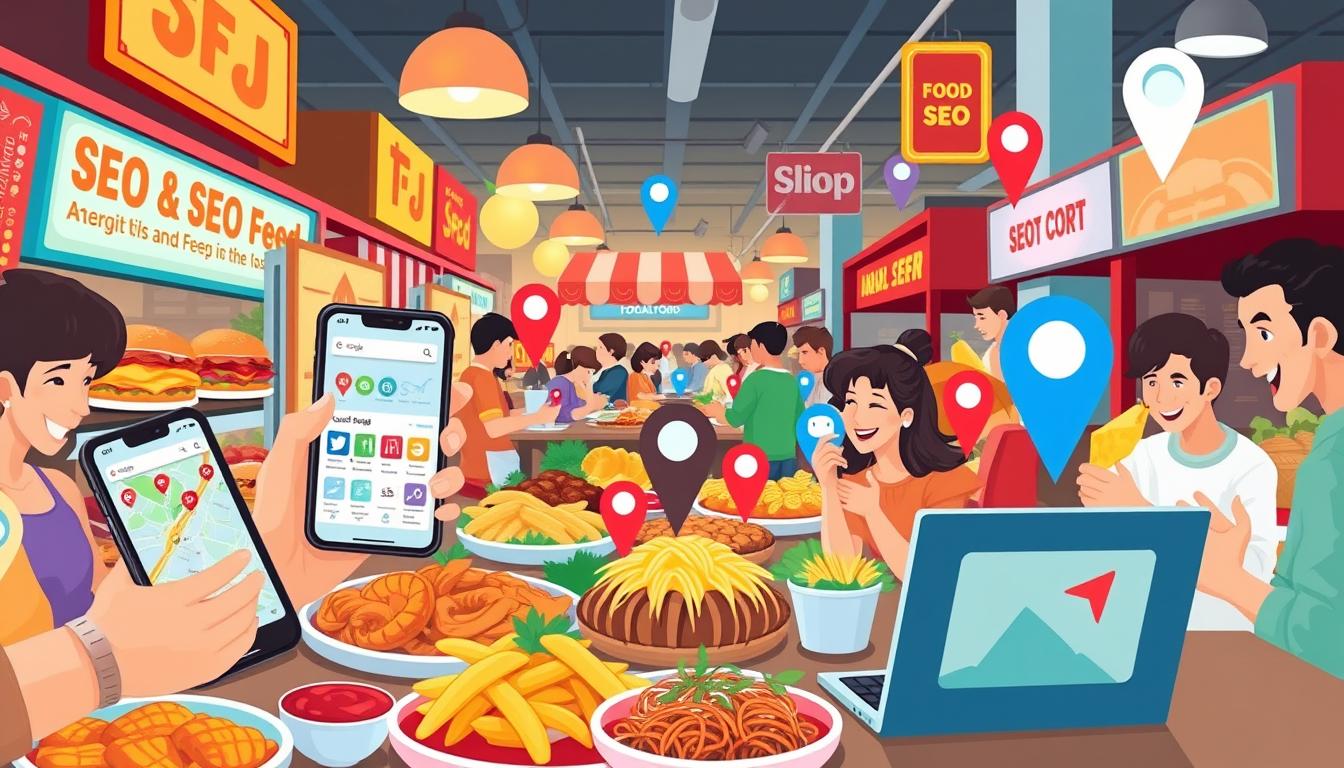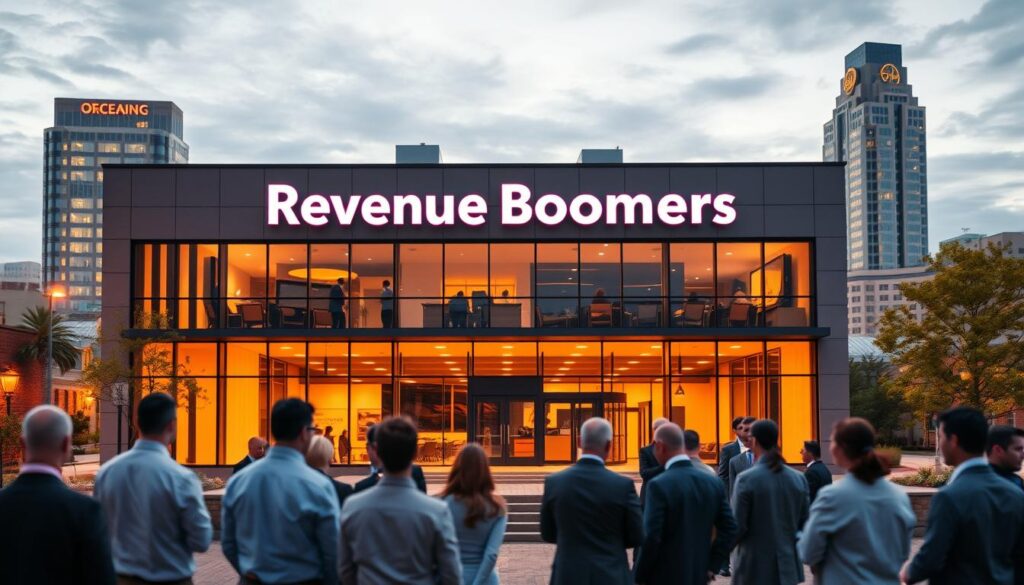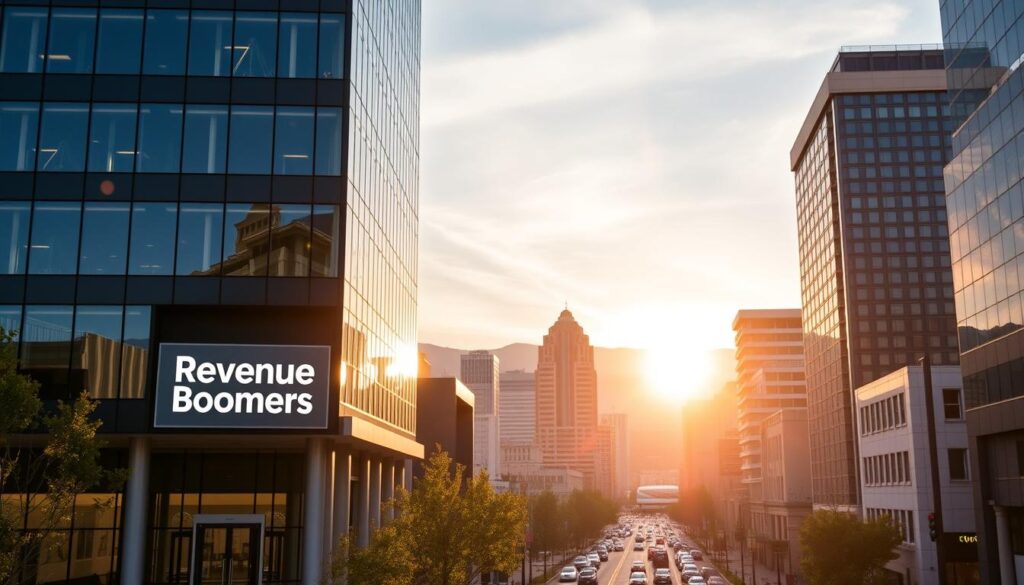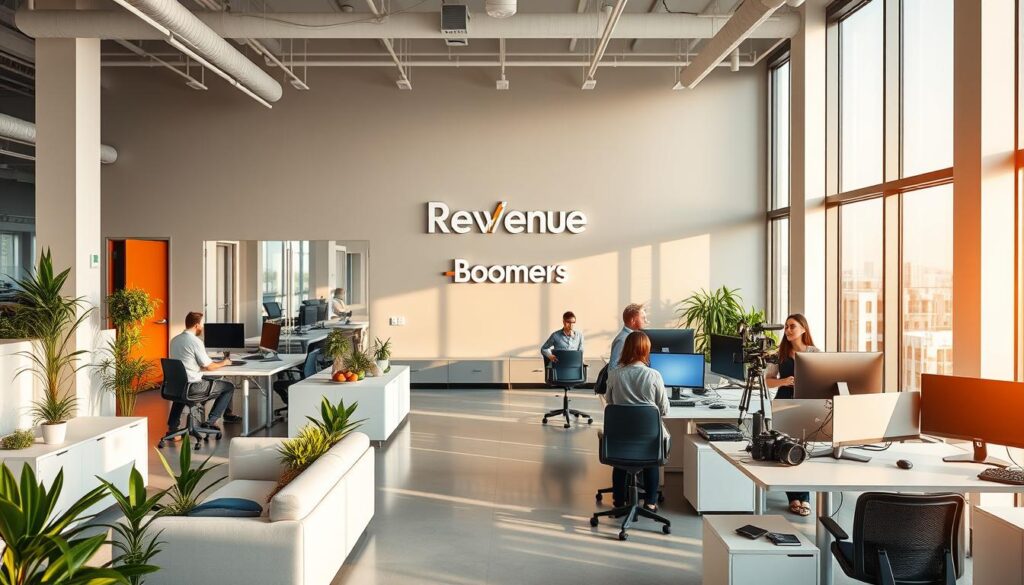Ever wondered why some food courts are always busy while others are empty? It might not be just about the food. It could be about their digital marketing. Knowing What Is Local SEO For Food Courts is key to getting more customers online. It helps food courts show up in search results, bringing in more people, sales, and good reviews.
With 46% of Google searches looking for local info and a 250% jump in “near me” searches since 2017, local SEO is vital. Food courts can use Google My Business and local keywords to grow their online presence. This guide will cover local SEO for food courts, including how to do it right and what to avoid. For more on local SEO for restaurants, check out this detailed guide.
Key Takeaways
- Local SEO is key for more foot traffic and sales in food courts.
- Optimizing Google My Business can greatly increase store visits.
- Using local keywords boosts search visibility and click-through rates.
- Good online reviews build trust in local businesses.
- Keeping an eye on local SEO can boost website traffic and sales.
- Getting local citations on trusted sites can improve search rankings.
Understanding Local SEO
Local SEO is key for businesses wanting to attract local customers. It makes sure businesses show up well when people search for services or products nearby.
Definition of Local SEO
Local SEO means making web pages better for searches about specific locations. It helps businesses show up in local search results, which can bring in more customers and sales.
Importance of Local SEO for Businesses
Local SEO is very important for businesses. About 71% of people looking for local businesses do it online. Also, 46% of all searches are for local stuff, showing how important a good local SEO strategy is.
Even more, 50% of people who search for local stores go there the same day. With more people using mobiles, having a strong online presence is more important than ever.
Key Components of Local SEO
Effective local SEO has a few key parts:
- Google My Business: Having an up-to-date profile is key for being seen locally.
- Local Keywords: Using local keywords helps in search results.
- Citations: Being listed correctly on sites like Yelp and Facebook helps credibility and rankings.
- Mobile Optimization: Most searches are on mobiles, so websites need to work well on them.
| Component | Description |
|---|---|
| Google My Business | A verified profile helps businesses appear in local searches and maps. |
| Local Keywords | Keywords that target geographical areas, enhancing search relevance. |
| Citations | Online listings that provide name, address, and phone number to boost local search rankings. |
| Mobile Optimization | Ensures that websites are user-friendly on mobile devices, critical for local search success. |
How Local SEO Benefits Food Courts
Local SEO is key for food courts to boost their online presence. It helps them show up more in search results and attract local customers. Knowing how to use local SEO is crucial for food courts to shine online.
Increased Visibility in Search Results
By optimizing for local search, food courts can rank higher in search results. People often search for “food near me” or “restaurants near me.” Using the right keywords helps food courts get noticed, especially with more people searching for food online.
Attracting Local Customers
Local food-related keywords like “fast food near me” and “Chinese food near me” get a lot of searches. By using these keywords, food courts can draw in customers looking for places to eat. As more people use mobiles to search, having a good online presence is key.
Local Competition and Market Share
Food courts compete to keep or grow their market share. Using local SEO, they can highlight what makes them special, like unique foods or dining experiences. This helps them stand out from chain restaurants and attract customers looking for something different.
| Keyword Phrase | Average Monthly Searches |
|---|---|
| Food Near Me | 10,000,000 |
| Restaurants Near Me | 10,000,000 |
| Breakfast Near Me | 2,600,000 |
| Fast Food Near Me | 1,600,000 |
| Chinese Food Near Me | 1,500,000 |
| Coffee Near Me | 1,300,000 |
| Italian Restaurants Near Me | 286,000 |
| Mexican Food | 392,000 |
| Chinese Restaurant | 122,000 |
Make the most of this by keeping up with local SEO strategies. Staying current and optimizing well can increase visibility and bring more customers to food courts.
Essential Local SEO Strategies for Food Courts
Using local SEO for food businesses is key to getting more online visibility and attracting customers. One important step is optimizing Google My Business profiles. This helps your food court show up in local search results and Google Maps. By adding details like hours, menu, and photos, you can draw in more online searchers.
Google My Business Optimization
Having a detailed Google My Business profile is crucial for food courts. It boosts visibility in local searches and helps engage potential customers. Make sure your name, address, and phone number (NAP) are right and the same everywhere. Also, keep your profile lively with new images and posts.
Building Local Citations
Building local citations is another key strategy. This means listing your NAP on sites like Yelp and TripAdvisor. It makes your food court look more credible and can improve your search rankings. Keeping your citations consistent is important to avoid confusing search engines and customers.
Collecting Customer Reviews
Customer reviews are very important for your food court’s reputation. By actively getting and responding to reviews, you can build a positive image. Positive feedback can encourage more people to visit, while responding to negative reviews shows you care about customer satisfaction. Since 91% of people trust online reviews as much as personal recommendations, managing your online reputation well is essential.
| Strategy | Description | Benefits |
|---|---|---|
| Google My Business Optimization | Ensuring your profile is complete and regularly updated with photos and posts. | Increased visibility in search results and enhanced engagement. |
| Building Local Citations | Listing your NAP consistently on local directories. | Improved credibility and higher search rankings. |
| Collecting Customer Reviews | Encouraging feedback and responding to reviews on various platforms. | Enhanced reputation and increased customer trust. |
Using these strategies can help your food court stand out online. It’s a great way to attract more customers. For more tips on local SEO and improving your food court website, check out this guide.
The Role of Keywords in Local SEO
Keywords are key for local SEO, especially for food courts. They help attract local customers. By using the right identifying target keywords, food courts can get more online visibility. This makes it easier for people to find them.
Identifying Target Keywords
Keyword research helps food courts find what people search for online. It’s about finding local dining trends and popular foods. Tools can help find these keywords, helping food courts stand out.
Long-Tail Keywords for Food Courts
Using long-tail keywords for food courts makes searches more relevant. For example, “best vegan food court in [city]” or “Italian food court near me.” These specific terms help food courts show up in the right searches and connect with users.
Using Keywords Effectively
Putting keywords in the right places on your website is important. Use them in meta descriptions, headings, and body text. Regular updates and blog posts with these keywords can also help. This way, food courts can get more visitors and improve their online presence. For tips on optimizing, check out local SEO effectiveness.
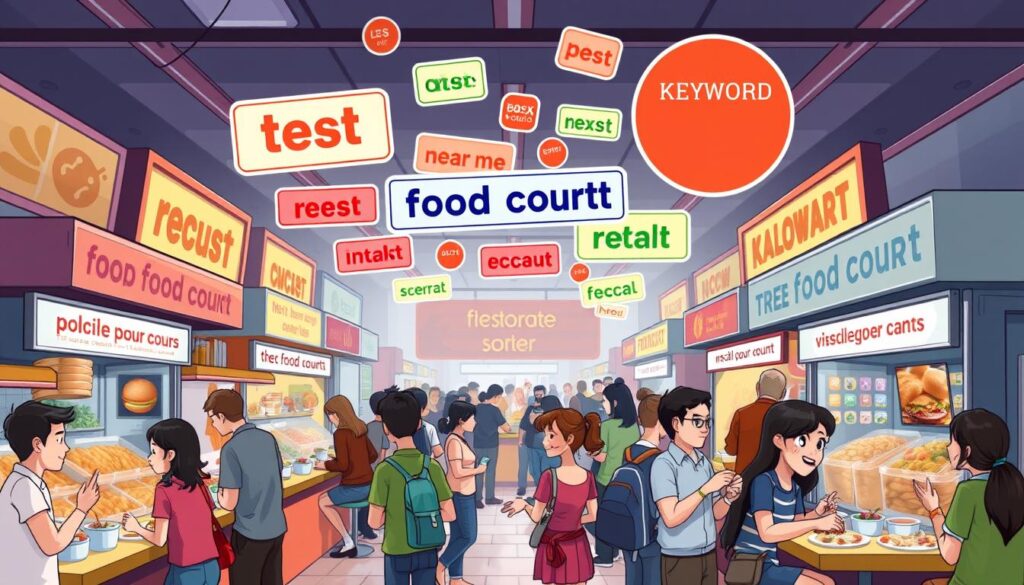
Content Marketing and Local SEO
Effective content marketing is key for better local SEO in food courts. A strategy that focuses on local content can improve search visibility. This attracts more local customers. Tailored content is essential, as generic content often misses the mark.
Blogging for Local Engagement
Blogging is a vital part of content marketing for food courts. Each blog post can highlight local dining trends, food festivals, or community events. This content connects well with locals and boosts digital marketing efforts.
Setting clear goals for these blogs is important. Goals like increasing website traffic or encouraging in-store visits can shape a better strategy.
Social Media Integration
Social media is great for local SEO. Using platforms like Instagram and Facebook can increase visibility and build community. User-generated content, like customer reviews, strengthens your local presence.
Working with local influencers can also expand your social media reach. It helps create real connections with your audience.
Importance of Visual Content
Visual content is essential to grab attention. Pictures of delicious dishes, promotions, and events can engage people. Using tools like Hootsuite helps keep your content consistent online.
Understanding what your audience likes helps improve your content. This ensures it stays relevant and interesting.
Mobile Optimization for Local SEO
As more people use their phones to search, food courts need to focus on mobile optimization. A responsive design helps websites work well on all devices. This makes sure websites load fast and are easy to use. Being mobile-friendly is key for happy users and better search rankings.
The Rise of Mobile Searches
Many searches now happen on smartphones. This shows how important it is for businesses to be mobile-friendly. If they’re not, they might lose customers who expect a smooth online experience. By using good local mobile marketing strategies, food courts can get more visibility and attract more mobile users.
Responsive Design for Food Courts
Responsive design makes mobile browsing better for food courts. It changes to fit any screen size, making content look good on any device. Important parts of a good design include:
- Fast loading times: Keeps users happy and reduces them leaving the site.
- User-friendly navigation: Easy-to-use sites make customers happier.
- Comprehensive contact information: Show the restaurant’s details clearly on every page.
Local Mobile Marketing Tactics
Food courts can use several local mobile marketing tactics, such as:
- Location-based promotions: Give special deals to people nearby.
- Mobile advertisements: Target ads to specific groups and places.
- Engagement through social media: Use platforms like Facebook and Instagram for contests and polls.

Using these mobile strategies meets what customers want and follows local SEO best practices. Tools like Google My Business and Yelp can also help. Investing in these tactics is key for food courts to connect with local customers.
| Tactic | Description | Benefits |
|---|---|---|
| Location-based Promotions | Offers targeted discounts to nearby customers. | Increases foot traffic and customer engagement. |
| Responsive Web Design | Adapts website layout for different device screens. | Enhances user experience and search ranking. |
| Social Media Engagement | Interactive posts and contests on platforms like Instagram. | Builds community and increases brand visibility. |
For more help, check out the basics of local SEO for businesses. Knowing these basics is crucial for making the most of mobile opportunities.
SEO Tools and Analytics
Using the right SEO tools is key for food courts to shine online. These tools give insights to track local SEO and tweak strategies. Software like Moz, SEMrush, and Google Analytics helps understand search performance better.
Tools for Monitoring Local SEO
Many SEO tools for food courts help track local SEO efforts well. They let businesses watch keyword rankings, online traffic, and competitors. Key monitoring tasks include:
- Keyword Performance Tracking
- Website Traffic Analysis
- Local Listings Management
- Backlink Monitoring
Analyzing Local SEO Performance
Analyzing local SEO performance means checking various metrics regularly. These metrics include:
| Metric | Description |
|---|---|
| Click-Through Rate (CTR) | Percentage of users who click on your listing after seeing it in search results. |
| Organic Traffic | Total number of visitors coming from search engines. |
| Page Load Speed | Time taken for the page to fully load, impacting user experience significantly. |
| Conversion Rate | Percentage of visitors who complete the desired action, such as making a purchase. |
| Reviews and Ratings | Overall sentiment and scores from customers, crucial for enhancing local presence. |
Reporting Results to Stakeholders
Reporting SEO results to stakeholders is vital for transparency and decision-making. Good reporting shows the value of SEO by highlighting better metrics and returns. This includes:
- Monthly Performance Summaries
- Yearly Growth Trends
- Competitor Analysis Reports
- Customer Feedback and Review Insights
Strong SEO practices help food courts keep and gain customers. Regular updates and detailed reports keep stakeholders in the loop about SEO strategy success. For more on this, see this guide to SEO for catering businesses.
Partnering with an SEO Agency
For food courts wanting to boost their online presence, teaming up with an SEO agency is key. Revenue Boomers crafts custom strategies for food businesses, helping them shine in a crowded market. With most users not going past the first page of search results, it’s crucial to have strong food court SEO strategies to draw in customers.
Why Choose Revenue Boomers
Choosing Revenue Boomers means picking an agency that gets local SEO and the food industry. They offer services like Google My Business optimization and local keyword research. This helps food courts connect with their audience. With more people using smartphones to search, optimizing online presence is essential, and Revenue Boomers is great at it.
Services Offered by Revenue Boomers
Revenue Boomers provides a range of local SEO services to boost visibility and customer interaction. They work on local citations, manage reviews, and use analytics to target the food court audience. This focused strategy increases foot traffic and builds brand loyalty.
Success Stories and Case Studies
Revenue Boomers has a solid track record of improving food courts’ online presence. They use tailored local SEO solutions to boost visibility and sales. Their case studies show how effective SEO can grow a business and engage customers.

